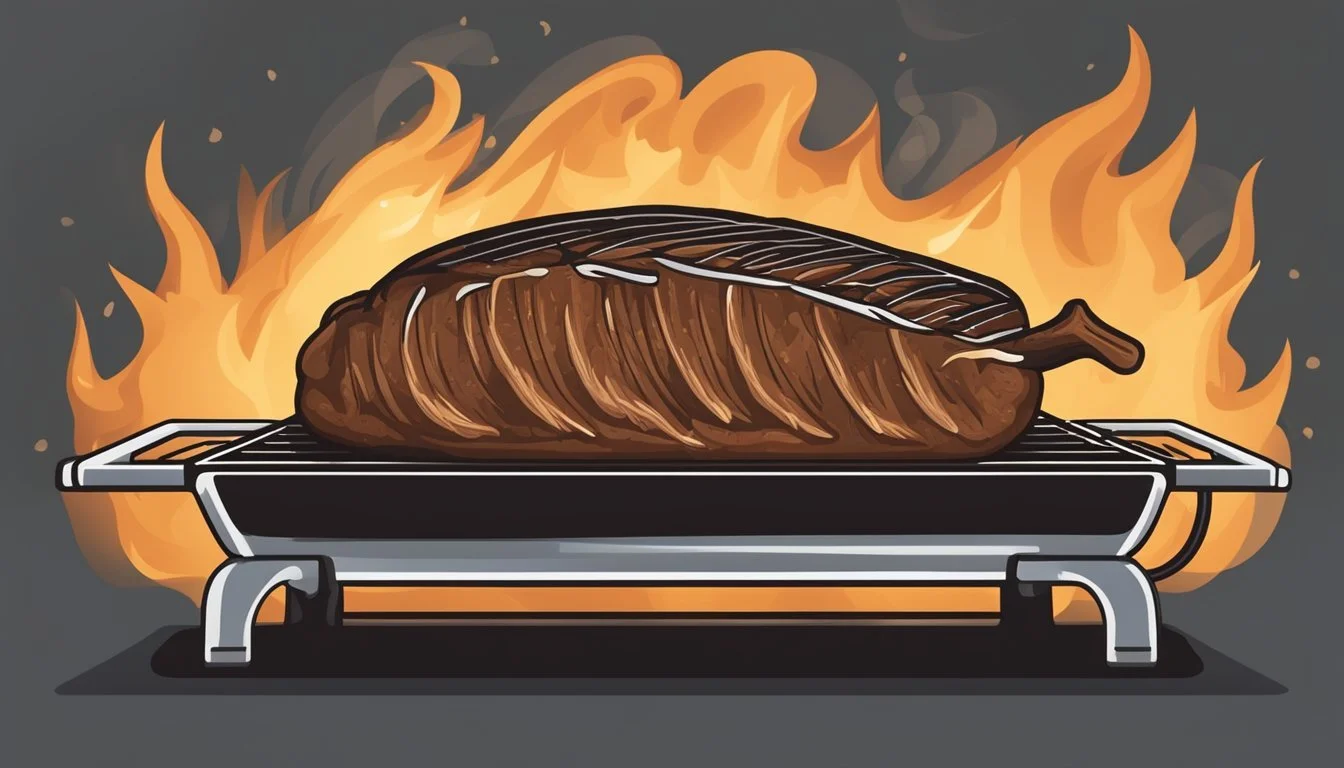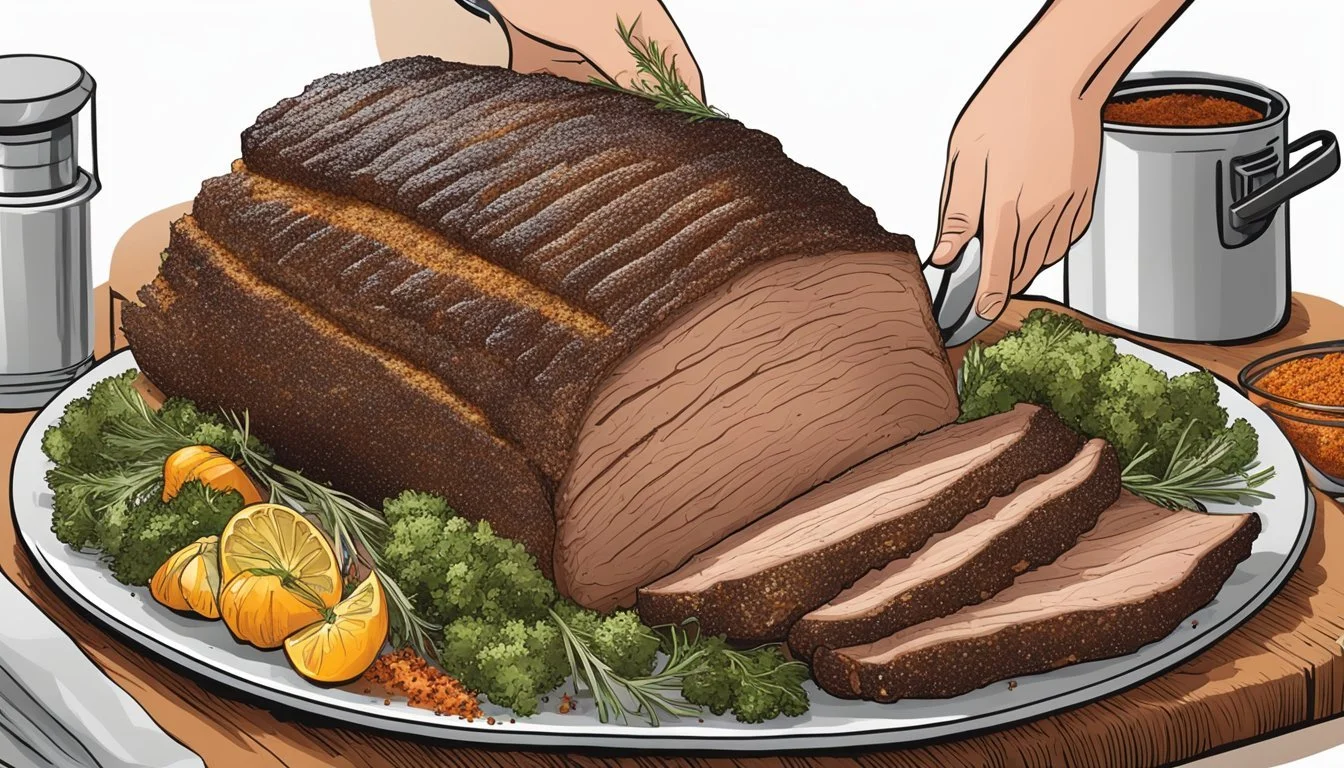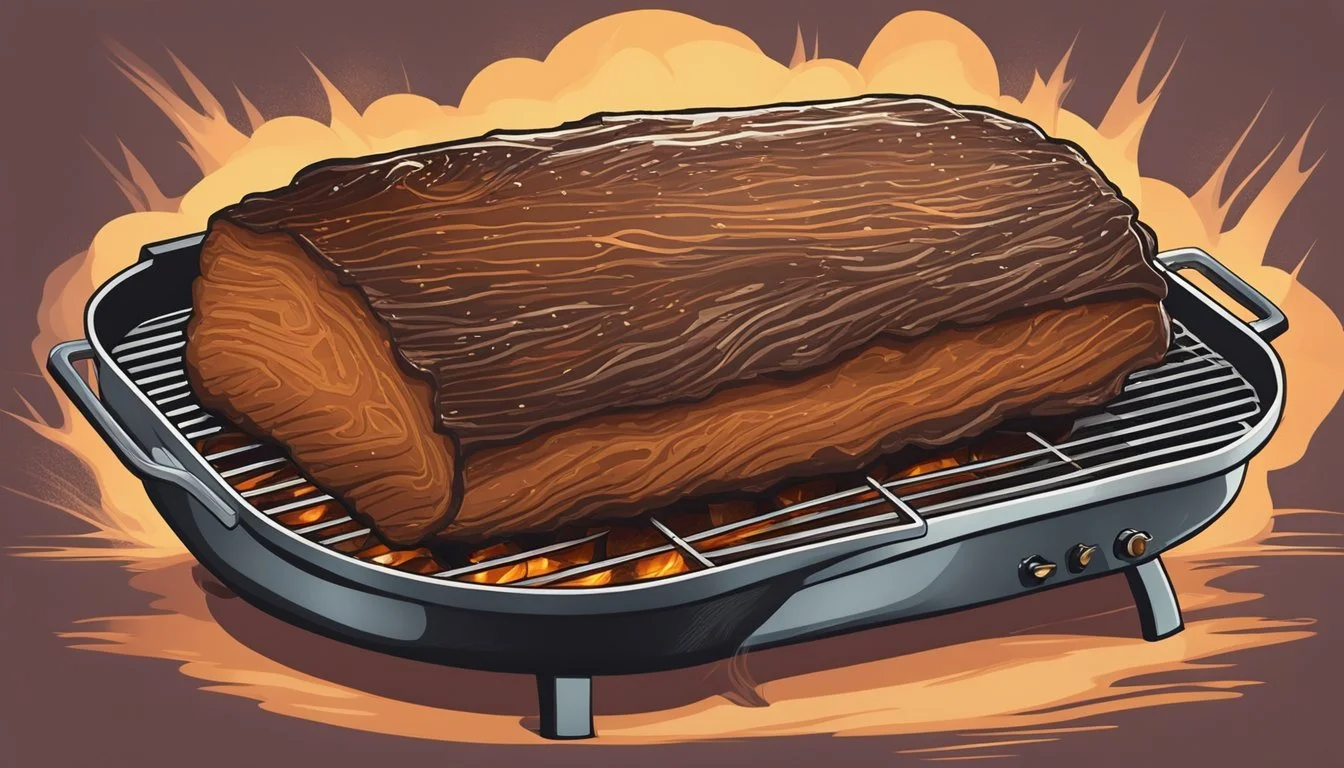How to Cook a 9 Pound Brisket
Tender and Flavorful Results
Cooking a 9-pound brisket is a rewarding endeavor for barbecue enthusiasts. This substantial cut of beef requires patience and careful attention to achieve mouthwatering results. Smoking a 9-pound brisket typically takes between 13.5 to 18 hours at 225°F, or about 1.5 to 2 hours per pound.
The cooking time can vary based on factors such as the smoker's temperature, the brisket's thickness, and whether it's wrapped during the process. At higher temperatures, like 250°F, the cooking time may decrease to around 9 to 13.5 hours. Pitmasters often aim for an internal temperature of 205°F to ensure the brisket is tender and juicy.
Preparation is key when smoking a brisket of this size. Trimming the fat cap to about 1/4 inch thickness and seasoning with a simple rub of salt, pepper, and garlic powder can enhance the flavor. Monitoring the internal temperature throughout the cooking process helps achieve the perfect balance of smoky exterior and succulent interior.
Selecting the Perfect Brisket
Choosing the right brisket is crucial for a successful smoke. Look for a whole packer brisket, which includes both the flat and point sections.
USDA Prime grade offers superior marbling, enhancing flavor and tenderness. However, Choice grade can also yield excellent results.
Aim for a brisket weighing 8-12 pounds. This size provides a good balance between cooking time and yield.
Inspect the fat cap. It should be evenly distributed and about 1/4 inch thick. Trim excess fat before cooking if needed.
Examine the meat's color. Fresh brisket should have a deep red hue without any gray or brown spots.
Check for flexibility. A quality brisket should bend easily when held at one end, indicating tenderness.
Look for visible marbling throughout the meat. This intramuscular fat contributes to moisture and flavor during the long cooking process.
Avoid briskets with hard fat or excessive gristle. These can lead to tough, unpleasant results.
When possible, choose from a reputable butcher or specialty meat supplier for the best quality and selection.
Prepping Your Brisket for Cooking
Start by trimming your 9-pound brisket. Remove excess fat, leaving about 1/4 inch of the fat cap intact. This helps keep the meat moist during cooking.
Trim off any silver skin or tough tendons. These won't break down during cooking and can make the brisket chewy.
Create a dry rub using kosher salt, black pepper, paprika, and a touch of cayenne for heat. Mix thoroughly in a bowl.
Some pitmasters prefer a slather before applying the rub. If desired, coat the brisket with a thin layer of mustard or oil.
Apply the dry rub generously to all sides of the brisket. Pat it in firmly to ensure good adhesion.
Let the seasoned brisket sit at room temperature for 30-60 minutes. This allows the rub to penetrate the meat and helps it cook more evenly.
While waiting, prepare your smoker or oven for low and slow cooking. Aim for a temperature of 225°F to 250°F.
Remember, patience is key when cooking brisket. Proper preparation sets the stage for a flavorful, tender result.
Choosing the Right Equipment
Selecting appropriate equipment is crucial for cooking a 9-pound brisket. The right tools ensure proper temperature control, smoke management, and overall cooking success.
Smoking on a Smoker
Smokers are ideal for cooking brisket. Offset smokers provide excellent temperature control and consistent smoke flow. Pellet smokers offer convenience with automated temperature regulation. For a 9-pound brisket, choose a smoker with ample cooking space.
Set the smoker temperature to 225°F for optimal results. Use wood chunks or pellets like oak, hickory, or mesquite for authentic flavor. Monitor internal smoker temperature with a reliable thermometer.
Maintain a steady temperature throughout the cooking process. Add fuel as needed to keep the smoke consistent. Consider using a water pan to help regulate humidity and temperature.
Utilizing a Grill
Grills can be adapted for smoking brisket. Use indirect heat by placing charcoal or wood chips on one side of the grill. Position the brisket on the opposite side.
Create a makeshift smoker box with aluminum foil and wood chips. Place it near the heat source for continuous smoke. Adjust vents to maintain a steady temperature of 225-250°F.
Monitor grill temperature closely, as it can fluctuate more than dedicated smokers. Use a dual-probe thermometer to track both grill and meat temperatures simultaneously.
Oven Cooking Strategies
Oven-cooking brisket is possible with some adjustments. Preheat the oven to 225-250°F. Place the seasoned brisket in a roasting pan or on a wire rack.
Add liquid smoke to mimic smoker flavor. Cover the brisket tightly with foil to retain moisture. Cook low and slow, allowing about 1.5 hours per pound.
Use a meat thermometer to monitor internal temperature. Remove the foil during the last hour for bark formation. Let the brisket rest before slicing.
Essential Tools and Accessories
Meat thermometer: Crucial for monitoring internal temperature
Aluminum foil or butcher paper: For wrapping the brisket
Large cutting board: For trimming and slicing
Sharp knife: Essential for proper trimming and slicing
Drip pan: Collects juices and maintains moisture
Heat-resistant gloves: For safe handling of hot meat
Consider investing in a wireless thermometer for continuous monitoring. A spray bottle filled with apple juice or beef broth helps keep the brisket moist during cooking.
Mastering the Cooking Process
Cooking a 9-pound brisket requires careful attention to temperature, timing, and technique. Achieving the perfect balance of tenderness and flavor depends on understanding key factors like cook time, temperature control, and the stall phenomenon.
Understanding Cook Time and Temperature
For a 9-pound brisket, plan on about 9-11 hours of cooking time at 250°F. This low and slow method allows the tough connective tissues to break down gradually. Cook with the fat side up to help baste the meat naturally.
Use a reliable meat thermometer to monitor the internal temperature. The target is 195-205°F for a tender, juicy brisket. Avoid opening the smoker too often, as this can extend cooking time.
Cooking times can vary based on factors like fat content and smoker efficiency. A general rule is 1 hour to 1 hour 15 minutes per pound at 250°F.
After cooking, allow a 1-2 hour resting period. This lets juices redistribute throughout the meat for optimal flavor and texture.
The Stall Phenomenon
The stall is a period during cooking when the brisket's internal temperature plateaus, typically around 150-170°F. This can last several hours and is caused by evaporative cooling.
During the stall, moisture from the brisket evaporates, cooling the meat and counteracting the heat from the smoker. This process can be frustrating but is a normal part of brisket cooking.
To push through the stall, maintain a consistent smoking temperature. Some cooks wrap the brisket in butcher paper or foil at this stage, known as the "Texas Crutch." This can help reduce cooking time but may affect bark formation.
Patience is key during the stall. Resist the urge to increase temperature, as this can lead to dry, tough meat.
The Art of Smoking Brisket
Smoking brisket is a time-honored tradition that transforms a tough cut of beef into tender, flavorful meat. The process begins with selecting a quality brisket, typically 9 to 12 pounds.
Preparation is key. Trim excess fat, leaving about 1/4 inch for moisture and flavor. Season generously with a simple rub of salt, pepper, and garlic powder.
Preheat the smoker to 225-250°F (107-121°C). Choose wood chips like hickory, mesquite, or post oak for authentic smoky flavor. Place the brisket fat-side up on the smoker grates.
Maintain a consistent temperature throughout the cooking process. This low and slow method allows the connective tissue to break down, resulting in tender meat.
Monitor internal temperature using a probe thermometer. The target range is 195-205°F (90-96°C) for optimal tenderness. Smoking time can vary, but plan for about 1 to 1.5 hours per pound.
Some pitmasters use the "Texas crutch" method, wrapping the brisket in foil or butcher paper when it reaches 165°F (74°C) internal temperature. This helps retain moisture and can speed up cooking time.
After smoking, let the brisket rest for 30-60 minutes before slicing. This allows juices to redistribute, ensuring a moist and flavorful result.
Resting and Serving
Resting a brisket is crucial for achieving tender, juicy meat. After removing the brisket from the smoker, wrap it tightly in foil or butcher paper. Place it in a cooler lined with towels, fat side up.
Let the brisket rest for 1-2 hours. This allows the juices to redistribute throughout the meat. For longer holds, a dry cooler can keep the brisket warm for up to 4 hours.
When ready to serve, unwrap the brisket and place it on a cutting board. Use a sharp knife to slice against the grain. Aim for pencil-thick slices to maximize tenderness.
A 9-pound brisket typically serves 12-15 people. Plan for about 1/2 pound of meat per person. Serve immediately for the best flavor and texture.
Consider accompaniments like barbecue sauce, pickles, and sliced white bread. These classic sides complement the rich, smoky flavor of the brisket.
Remember to save any leftover juices from the foil. These can be spooned over the sliced meat for extra moisture and flavor.
Storing and Reheating Leftovers
Proper storage is crucial for preserving brisket leftovers. After cooling, wrap the meat tightly in plastic wrap or aluminum foil. Place it in an airtight container and refrigerate within 2 hours of cooking.
Refrigerated brisket stays fresh for 3-4 days. For longer storage, freeze portions in vacuum-sealed bags or freezer-safe containers for up to 3 months.
To reheat, let refrigerated brisket sit at room temperature for 15-20 minutes. Preheat the oven to 325°F (165°C). Place brisket in an oven-safe dish with a splash of beef broth or original cooking liquid.
Cover tightly with foil and heat for 20-30 minutes per pound, until the internal temperature reaches 165°F (74°C). Avoid overheating to prevent drying out the meat.
For quicker reheating, use a slow cooker on low for 2-3 hours. Add reserved juices to maintain moisture. Slice the brisket if it's too large to fit.
Microwave reheating is not recommended, as it can lead to uneven heating and dry out the meat. If necessary, use short intervals and add moisture.
Properly reheated brisket should be tender and juicy, closely resembling its freshly-cooked state.
Additional Tips and Tricks
Use a boning knife to trim excess fat from the brisket, leaving about 1/4 inch for flavor. Apply a dry rub generously, including coarse ground black pepper for a classic Texas-style taste.
Monitor the weather, as it can affect cooking times. Wind and cold temperatures may extend the process. Patience is key - rushing can lead to tough meat.
Place a water pan in the smoker to maintain moisture. This helps prevent the brisket from drying out during the long cook time.
The size of the brisket impacts cooking duration. A 9-pound brisket typically takes 12-15 hours at 225°F. Plan accordingly.
Wrap the brisket in butcher paper or foil when it reaches an internal temperature of 165°F. This helps push through the stall and retain moisture.
Allow the brisket to rest for 1-2 hours after cooking. This lets the juices redistribute, resulting in a more tender final product.
Consider the cost. While brisket can be expensive, proper cooking techniques ensure you get your money's worth.
Use a meat thermometer to check for doneness. The target temperature is 195-205°F. At this point, the connective tissues break down, creating a tender result.








